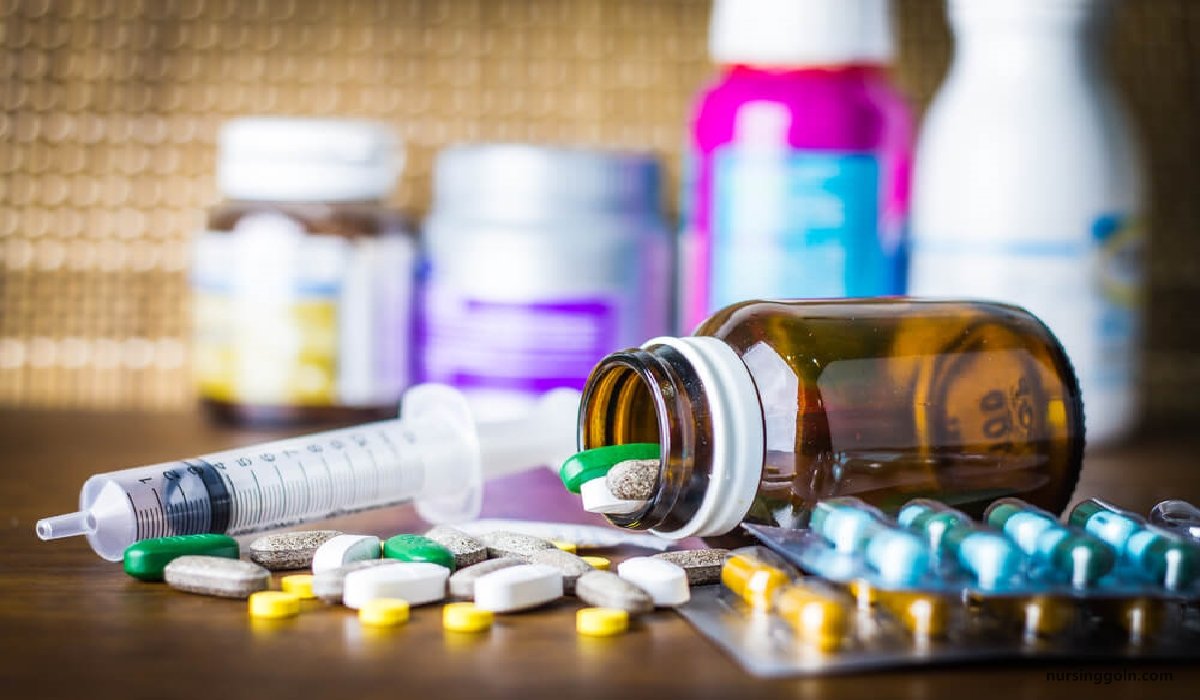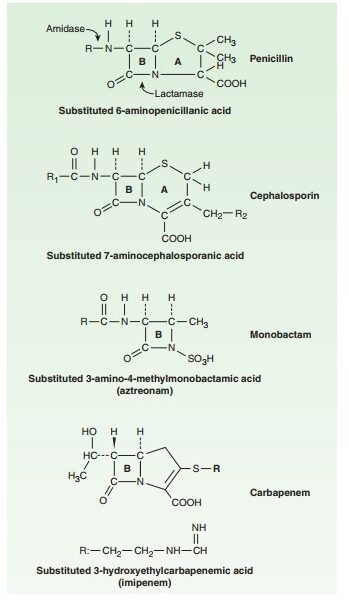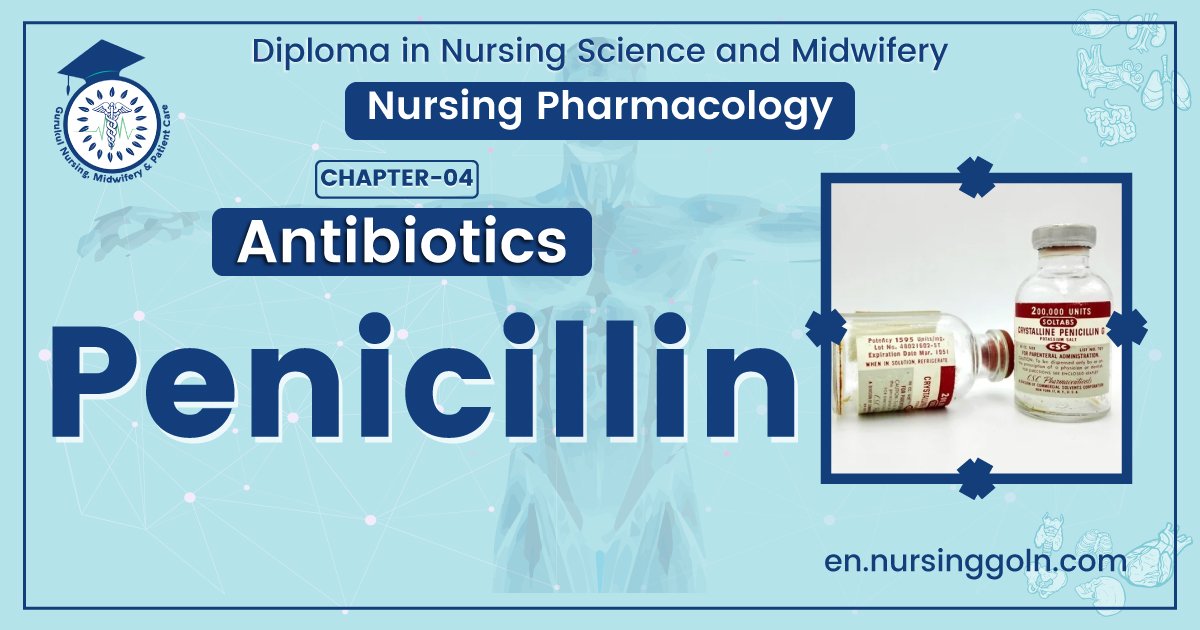Concept of Penicillin – This book covers the entire syllabus of “Pharmacology” prescribed by BNMC- for a diploma in nursing science & midwifery students. We tried to accommodate the latest information and topics. This book is an examination set up according to the teachers’ lectures and examination questions.
At the end of the book, previous questions are given. We hope in touch with the book students’ knowledge will be upgraded and flourish. The unique way of presentation may make your reading of the book a pleasurable experience.

Concept of Penicillin
The penicillins share features of chemistry, mechanism of action, pharmacology, and immunologic characteristics with cephalosporins, monobactams, carbapenems, and ẞ-lactamase inhibitors. All are ẞ- lactam compounds, so named because of their four-membered lactam ring.
- Penicillins are lipid insoluble.
- Cannot cross the blood brain barrier.
- Can cross the placental barrier.
Source
1. Natural:
- Penicillum notatum (previously)
- Penicillium chrysogennum (now a day)
2. Synthetic.
A. Semisynthetic.
Chemistry
All penicillins have the basic structure like below A thiazolidine ring (A) is attached to a ẞ-lactam ring (B) that carries a secondary amino group (RNH-)
Substituents can be attached to the amino group.
Structural integrity of the 6- aminopenicillanic acid nucleus (rings A plus B) is essential for the biologic activity of these compounds.
Hydrolysis of the B-lactam ring by bacterial B-lactamases yields penicilloic acid, which lacks antibacterial activity.
B-lactam ring is responsible for the antibiotic action Thiazolidine ring is responsible for absorption, distribution and hypersensitivity reaction of the penicillin Different radicals attached to free amino group determine the pharmacological properties of the new drug.

Classification of penicillin
Substituents of the 6- aminopenicillanic acid moiety determine the essential pharmacologic and antibacterial properties of the resulting molecules.
Penicillins can be assigned to one of three groups (below). Within each of these groups are compounds that are relatively stable to gastric acid and suitable for oral administration, eg. penicillin V, dicloxacillin, and amoxicillin.
A. Penicillins (eg, penicillin G)-These have greatest activity against gram-positive organisms, gram- negative cocci, and non-ẞ-lactamase-producing anaerobes. However, they have little activity against gram-negative rods, and they are susceptible to hydrolysis by B-lactamases.
B. Antistaphylococcal penicillins (eg, nafcillin)-These penicillins are resistant to staphylococcal B-lactamases. They are active against staphylococci and streptococci but not against enterococci, anaerobic bacteria, and gram-negative cocci and rods.
C. Extended-spectrum penicillins (aminopenicillins and antipseudomonal penicillins)- These drugs retain the antibacterial spectrum of penicillin and have improved activity against gram-negative organisms. Like penicillin, however, they are relatively susceptible to hydrolysis by ẞ-lactamases.
Clinical uses of the penicillins
Penicillins are given by mouth or, in more severe infections, intravenously, and often in combination with other antibiotics. M Uses are for sensitive organisms and may (but may not: individual sensitivity testing is often appropriate depending on local conditions-see below) include:
- Bacterial meningitis (e.g. Caused by neisseria meningitidis, streptococcus pneumoniae): benzylpenicillin, high doses intravenously
- Bone and joint infections (e.g. With staphylococcus aureus): flucloxacillin
- Skin and soft tissue infections (e.g. With strep. Pyogenes orstaph. Aureus): benzylpenicillin, flucloxacillin; animal bites: co-amoxiclav
- Pharyngitis (from strep. Pyogenes): phenoxylmethyl penicillin
- Otitis media (organisms commonly include strep. Pyogenes, haemophilus influenzae): amoxicillin
- Bronchitis (mixed infections common): amoxicillin
- Pneumonia: amoxicillin
- Urinary tract infections (e.g. With escherichia coli):amoxicillin
- Gonorrhea: amoxicillin (plus probenecid)
- Syphilis: procaine benzylpenicillin
- Endocarditis (e.g. With strep. Viridans or enterococcus faecalis): high-dose intravenous benzylpenicillinsometimes with an aminoglycoside
- Serious infections with pseudomonas aeruginosa: ticarcillin,piperacillin.
This list is not exhaustive. Treatment with penicillins is sometimes started empirically, if the likely causative organism is one thought to be susceptible to penicillin, while awaiting the results of laboratory tests to identify the organism and determine its antibiotic susceptibility.
Prophylactic uses of penicillin.
Prophylactic uses
➤ Rheumatic fever: Low concentrations of penicillin prevent colonization by streptococci that are indirectly responsible for rheumatic fever. Benzathine penicillin 1.2 MU every 4 weeks till 18 years of age or 5 years after an attack, whichever is more.
➤ Bacterial endocarditis: Dental extractions, endoscopies, catheterization, etc. cause bacteremia which in patients with valvular defects can cause endocarditis. PnG can afford protection, but amoxicillin is preferred now.
➤ Agranulocytosis patients: Penicillin has been used alone or in combination with streptomycin to prevent respiratory and other acute infections, but cephalosporins + an aminoglycoside or fluoroquinolone are preferred now.

List Pharmacokinetics of penicillin.
Pharmacokinetics of penicillin
➤ Route of administration: Oral, parenteral (I/v, I/M)
➤ Distribution: Widely distributed. If meninges are inflamed it can enters into the CSF.
➤ Plasma half-life: Usually <2 hours. Mainly renal and rapidly occurs.
➤ Excretion: 90% by tubular secretion.
adverse effects of penicillins. (BNMC- Dec 2021)
Adverse effects of penicillins
Hypersensitivity:
Approximately 5% percent of patients have some kind of reaction, ranging from rashes to angioedema (marked swelling of the lips, tongue, and periorbital area) and anaphylaxis.
Diarrhea:
Diarrhea is a common problem that is caused by a disruption of the normal balance of intestinal microorganisms.
Nephritis:
Penicillins, particularly methicillin, have the potential to cause acute interstitial nephritis. [Note: Methicillin is therefore no longer used clinically.]
Neurotoxicity:
The penicillins are irritating to neuronal tissue, and they can provoke seizures if injected intrathecally or if very high blood levels are reached. Epileptic patients are particularly at risk due to the ability of penicillins to cause GABAergic inhibition.
Hematologic toxicities:
Decreased coagulation may be observed with high doses of piperacillin, ticarcillin, and nafcillin (and, to some extent, with penicillin G). Cytopenias have been associated with therapy of greater than 2 weeks, and therefore, blood counts should be monitored weekly for such patients.

Flucloxacillin
Properties:
➤Flucloxacillin is a penicillinase (B-lactamase) resistant antibiotic (drug of choice against penicilliase producing staphylococci).
➤ Bacteriocidal antibiotic, active against gram positive bacteria.
➤ Flucloxacillin is not destroyed by gastric acid (acid resistant) therefore orally active.
Indication of flucloxacillin
1. Respiratory tract infections:
➤ Pneumonia
➤ Lung abscess
➤ Empyema
➤ Sinusitis
2. Skin and soft tissue infections:
➤ Boils
➤ Abscess
➤ Carbuncles
➤ Cellulitis
➤Infected wound
➤ Infected burns
Broad Spectrum Penicillins
➤ Ampicillin
➤ Amoxacillin
➤ Azlocillin
➤ Pivampicillin
➤ Ticarcillin

Indications/Uses
These semisynthetic penicillins are active against a variety of gram-negative bacilli as well.
➤ Acid resistant (not destroyed by HCI)
➤ Short duration of action (4-6 hours)
➤ Destroyed by beta-lactamase.
1. Respiratory tract infections (RTI) Sinusitis Tonsillitis Bronchitis Otitis media
2. Urinary tract infections (UTI)
Meningitis due to –
➤Influenzae
➤ Meningococci
➤ Pneumococci
3. Gonorrhoea.
4. Enteric fever (typhoid and paratyphoid): amoxacillin.
5. Bacillary dysentery (ampicillin).
Read more:
